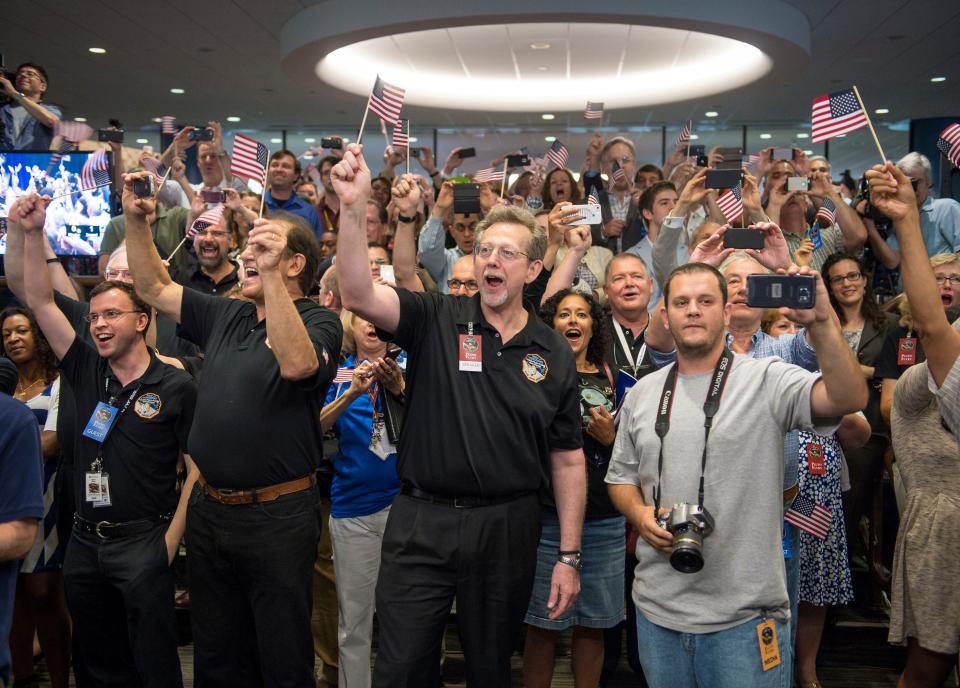From Burlington to NASA, Jim Green's sky is the limit
Jim Green, a Burlington native and Burlington High School graduate, is retiring this year as NASA's Chief Science Officer.
NASA released a statement in September announcing Green's early 2022 retirement.
A Jan. 2 New York Times piece notes Green said that we can transform Mars and maybe Venus, and that for decades, Green has shaped much of the space agency’s scientific inquiry.
Green's star rose steadily since 1980 when, with a Ph.D. in space physics from the University of Iowa, he started at National Aeronautics and Space Administration.
His positions at the governmental space agency include head of the National Space Science Data Center, chief of the Space Science Data Operations Office, chief of the Science Proposal Support Office, and most recently, the director of NASA's planetary sciences division.
From starting up NASA’s first internet to conducting groundbreaking research to hosting NASA’s popular podcast “Gravity Assist,” Green’s contributions to the agency are countless and varied.
“I feel tremendously proud about the activities I’ve done at NASA,” Green said in the release. “In many ways, NASA is not a job. It’s a way of life. We’re always looking for ways to do the impossible. The fact that we continue to succeed and do those things is a tremendous excitement for everyone, and really is important not just for NASA, but for the nation.”
Green, who has a keen interest in extraterrestrial life, approved plans for the Perseverance rover, which landed on Mars in February 2021.
"Where there is water, there is life," he told CNN before the 2020 Mars Rover was set to launch and once landed, drill down to collect several dozen samples from deep in Mars' surface, a move he felt "could rock astrobiology."
More: After decades of planning, NASA's $10 billion space telescope has 'taken its final form'
After drilling miles into the Earth, researchers found more life in the Earth’s crust than on its surface, he said.
Currently, scientists are working to fix a clog caused by pebbles in a sixth surface collection by Perseverance, which has spotted a purple coating on Mars rocks, and now is exploring a crater on the dusty planet that was once a river delta.
Judy Smithson-Hilkins of the Southeast Iowa Astronomy Club organized public speaking events by Green in August 2017 when he came back to Burlington to celebrate the 30th anniversary of the Witte Observatory's 12-inch Alvan Clark and Sons refracting telescope.
During his visit, Green spoke with students at Aldo Leopold and Edward Stone middle schools about his work in astronomy, and he hosted a public presentation about the search for alien life.
He talked about the search for alien life at both Edward Stone presentations, but said that doesn't mean friendly, sentient aliens are going to start falling from the sky.
"We are looking for life that metabolizes, reproduces and evolves. That's our definition of life. And indeed, that can be very small. It could be microbial. In the solar system, there's only a couple of places where complex life even has a chance to survive, other than the earth. One of the first places we're looking for life is Mars," Green said.
"Three-and-a-half billion years ago, Mars looked like the Earth. It had an enormous amount of water, it had a fabulous atmosphere, and it was the same time life started here on Earth," he said.
More: 'It's an employees' market': Burlington employers get creative to attract, retain staff
Throughout his 12 years as director of planetary sciences, Green said some of his proudest accomplishments included launching the Curiosity Rover and landing it on Mars in 2012, flying by Pluto and putting a spacecraft into orbit around the largest-known asteroid.
With the Mars Curiosity landing, which employed a risky and complicated maneuver involving, for the first time, a "sky crane," he helped ensure that the world would celebrate the successful touchdown.
“I came to realize how important it was to tell the public what we were doing, to bring them along for the ride,” he said. “That really started with the landing of Curiosity.”
More: NASA and Tide are working on a long-standing space problem: cleaning astronauts' laundry
Under Green’s leadership, NASA also successfully saw Juno investigate Jupiter, MESSENGER study Mercury, Dawn orbit both Vesta and Ceres, New Horizons fly by Pluto, and much more.

He helped develop a new way to engage the public in 2016 when he was invited to host a NASA podcast.
The show “Gravity Assist” is like eavesdropping on two scientists talking about the latest astronomical discoveries over lunch.
He named it “Gravity Assist” after the boost in speed that a spacecraft gets when it flies by a planetary body.
This article originally appeared on The Hawk Eye: Burlington native, NASA Chief Space Officer Jim Green retires

